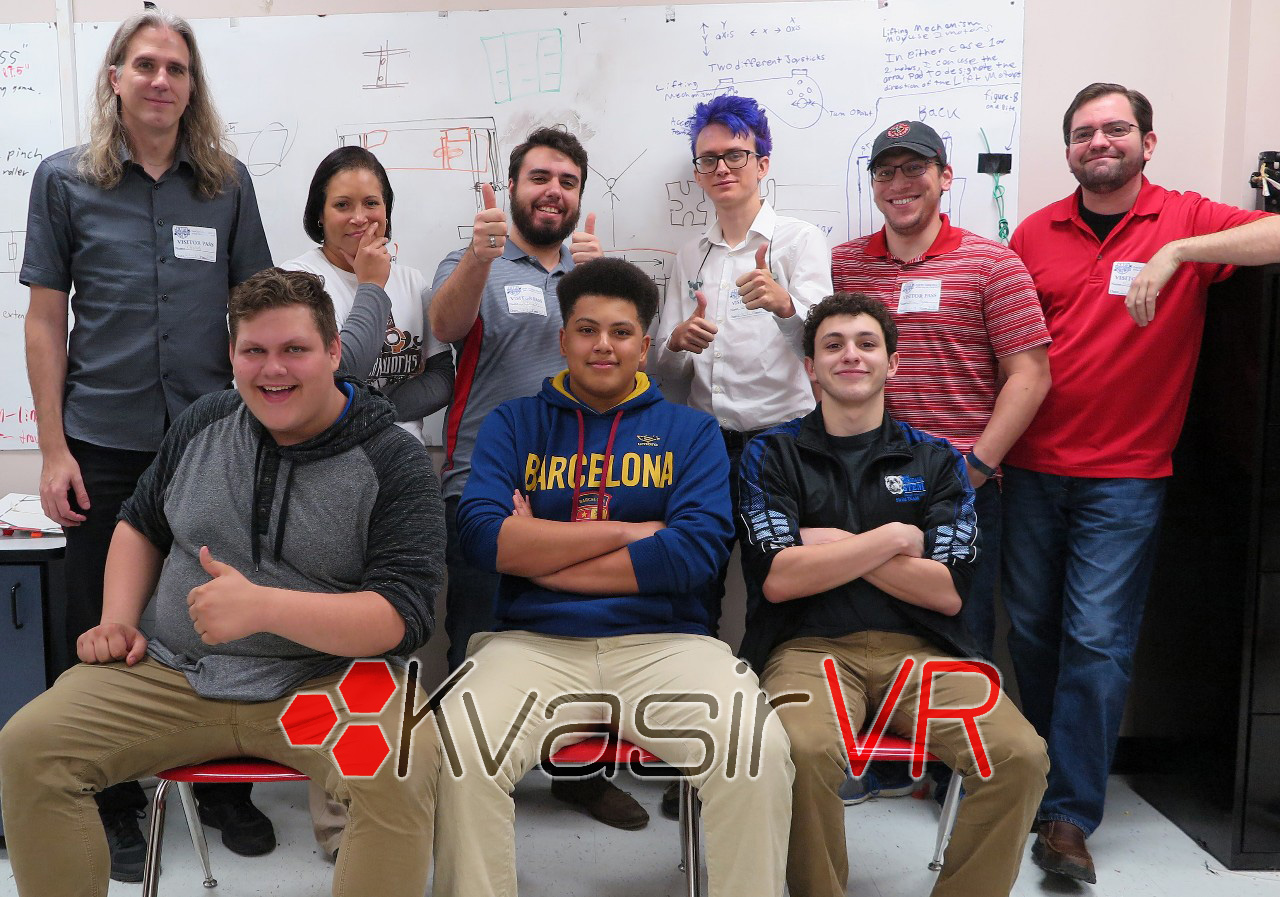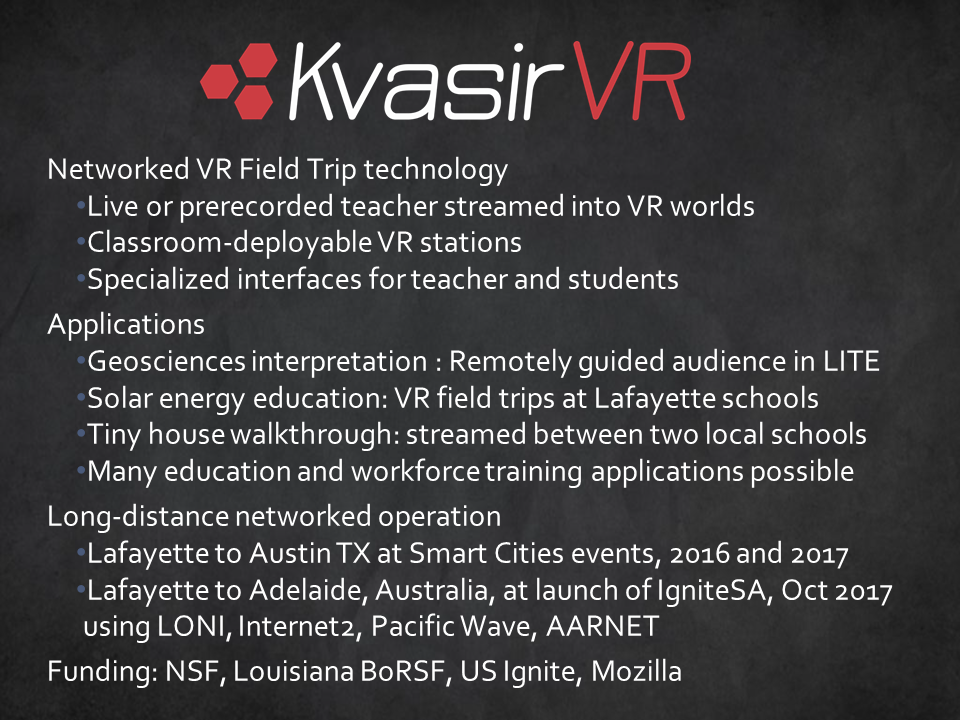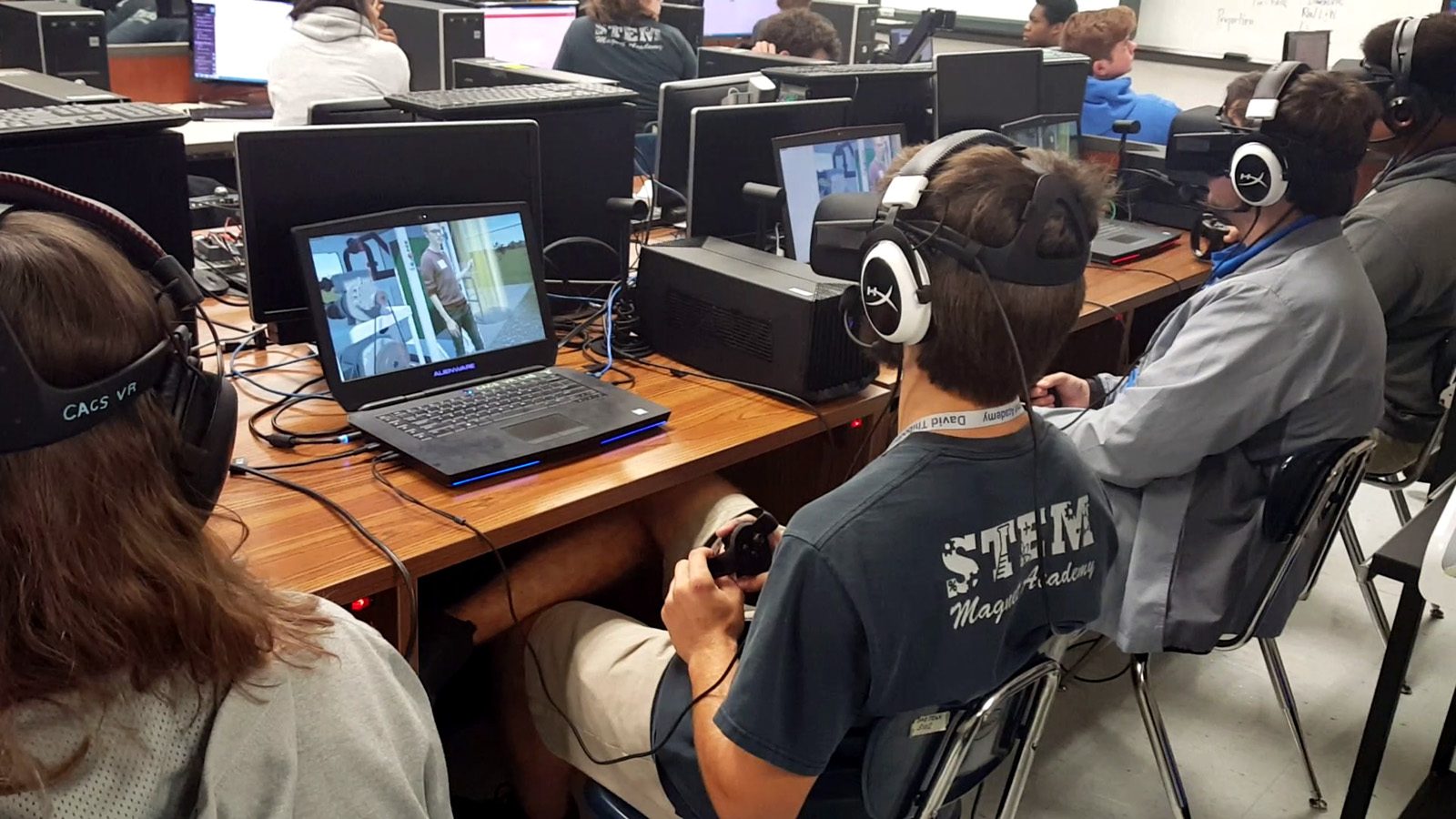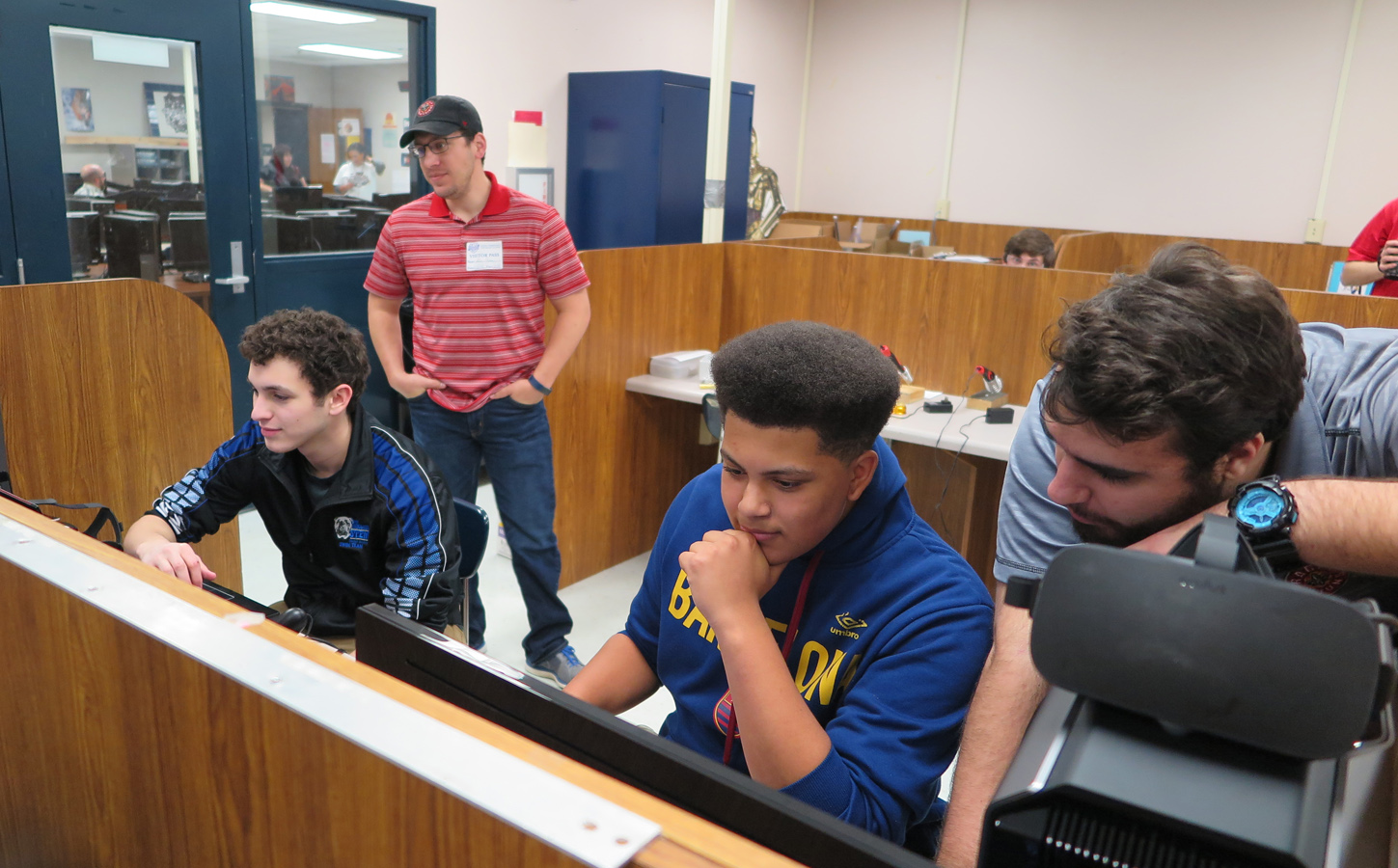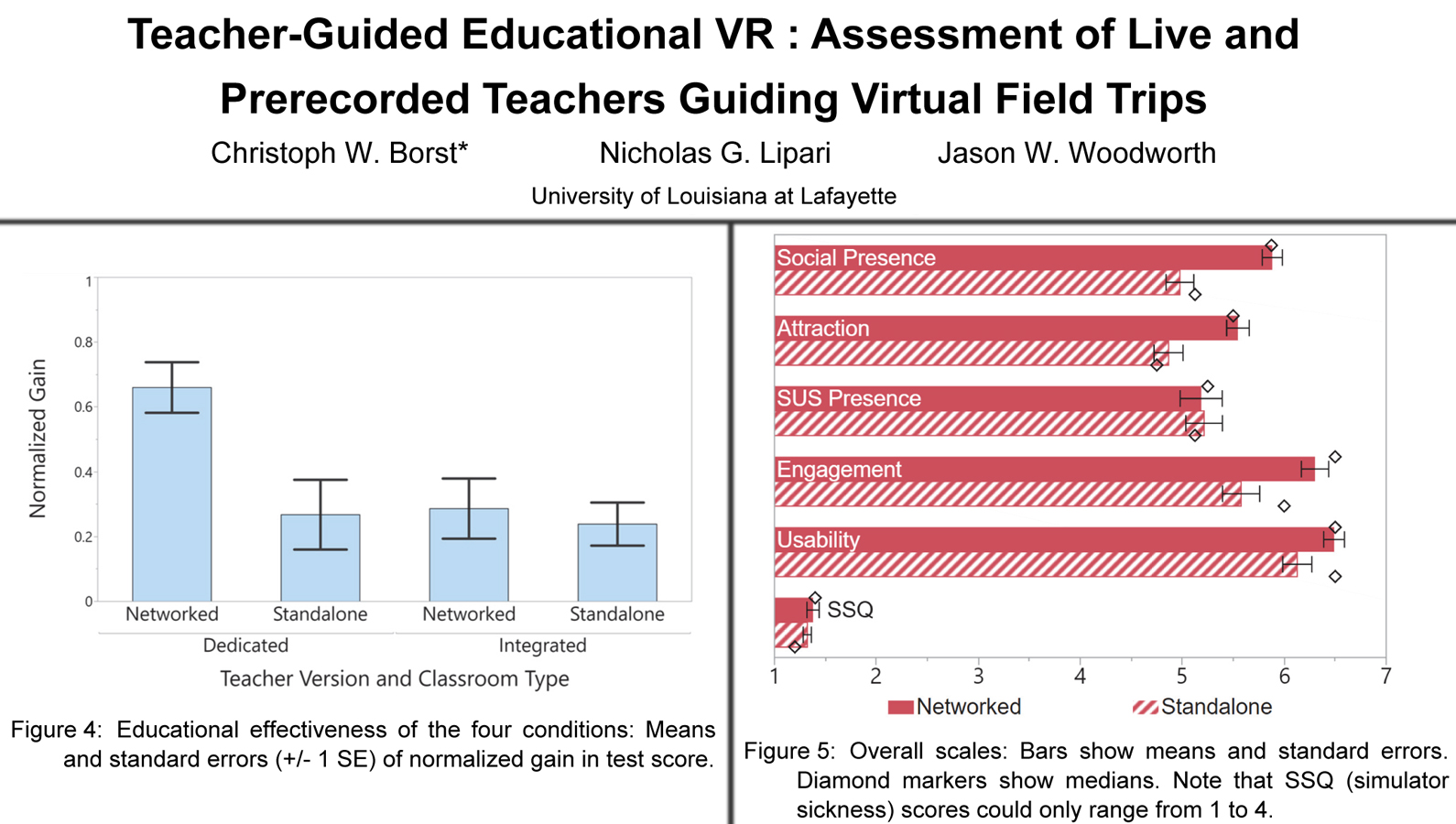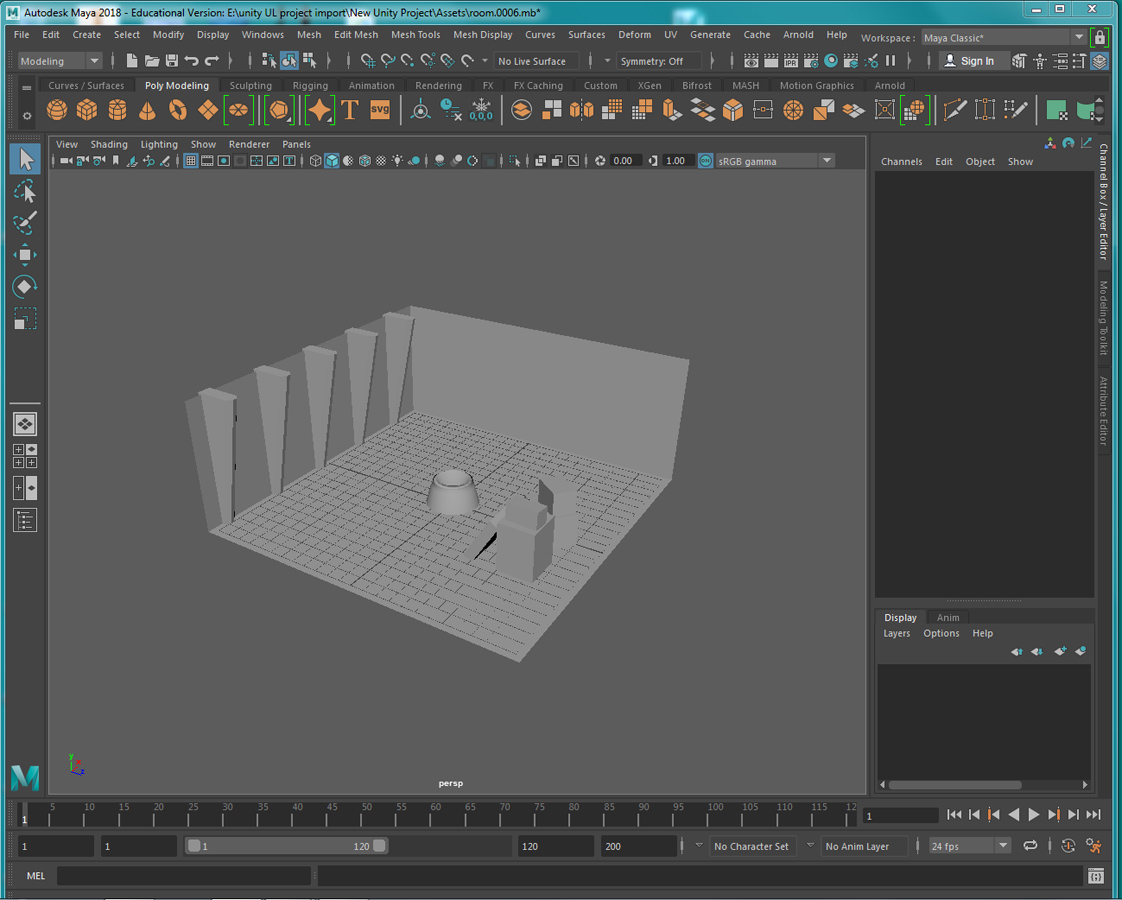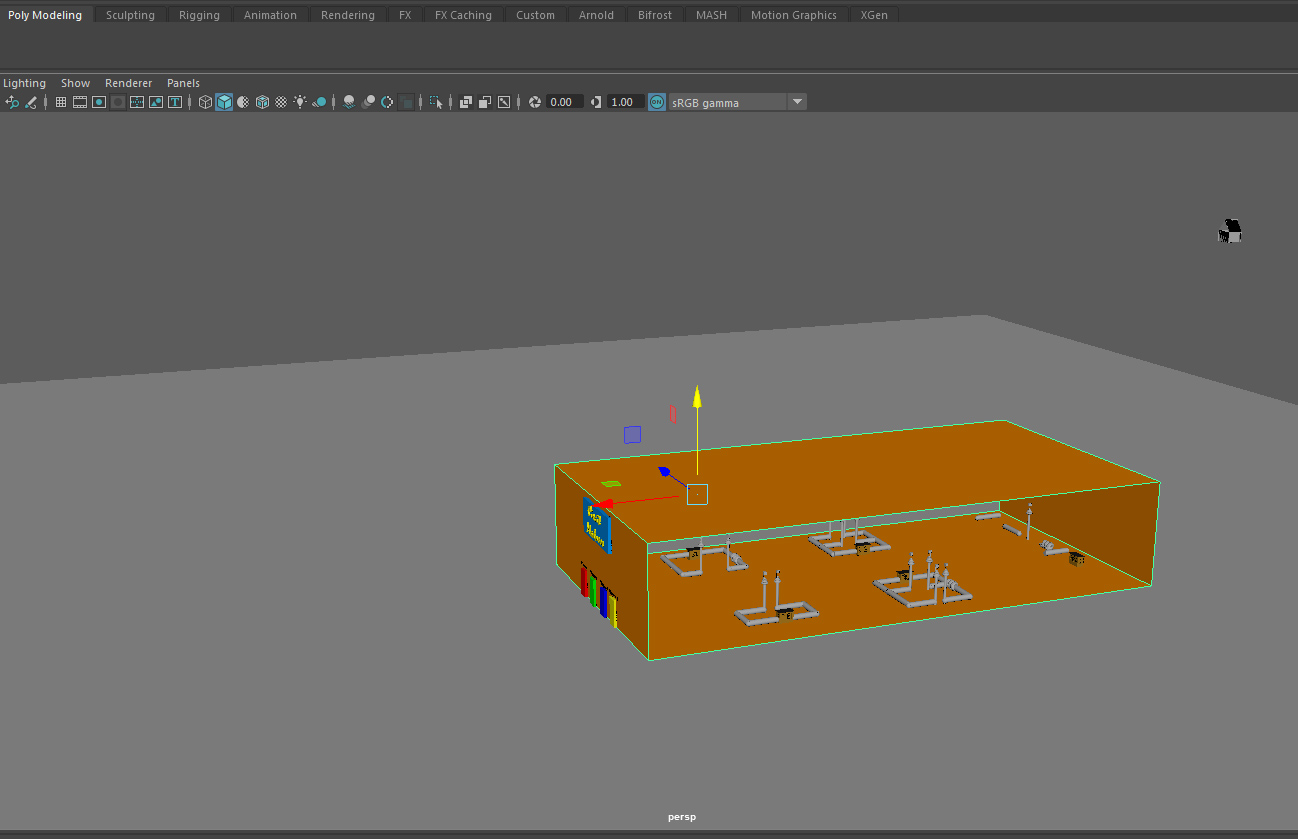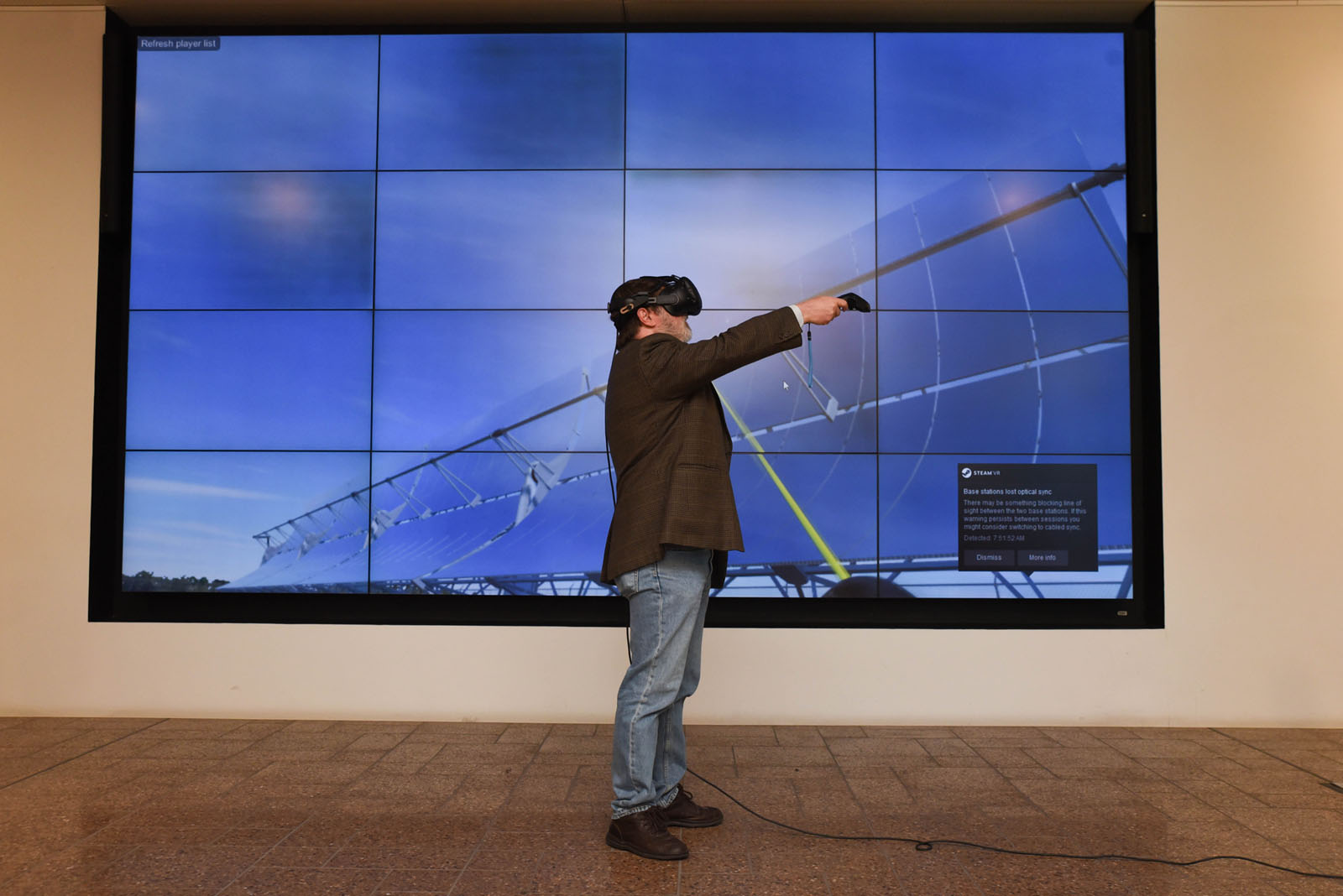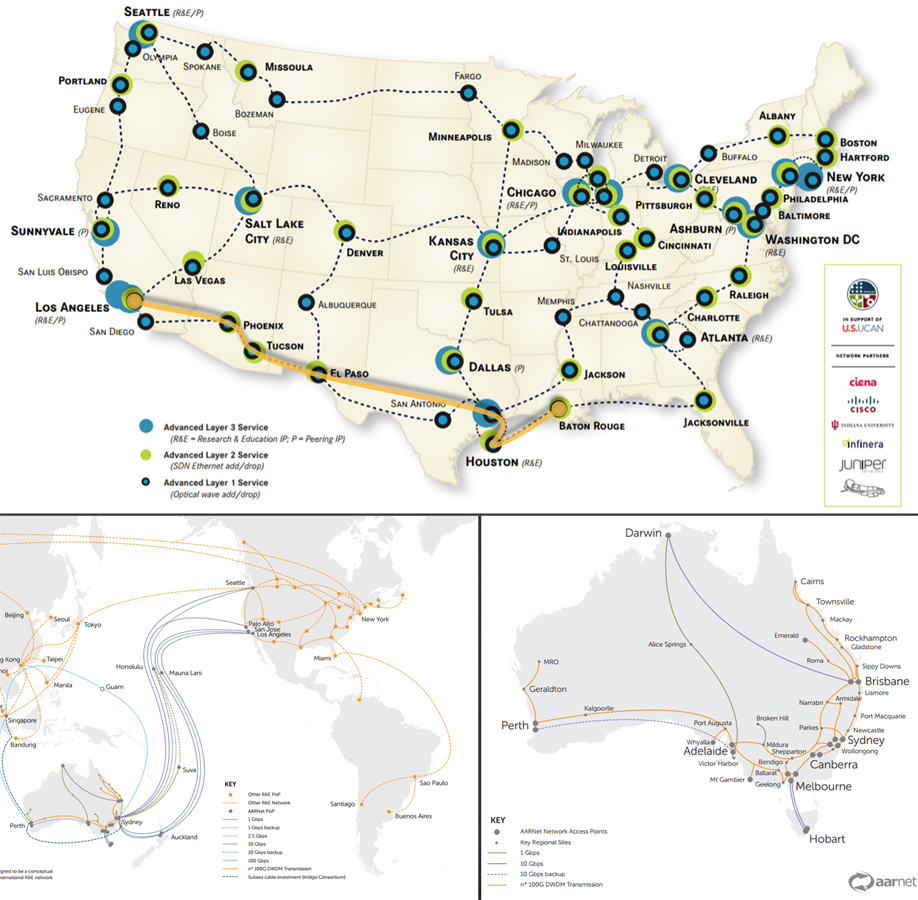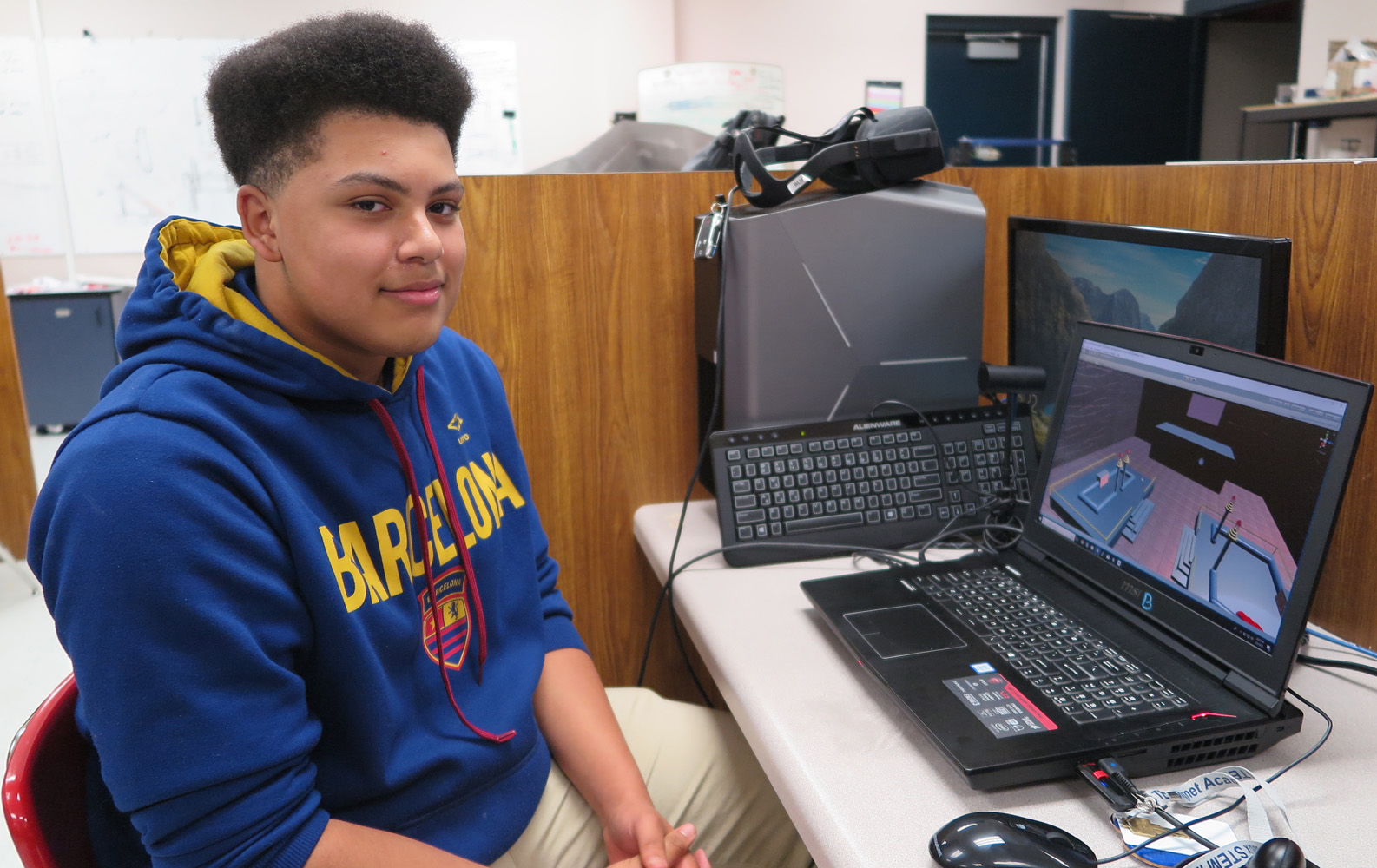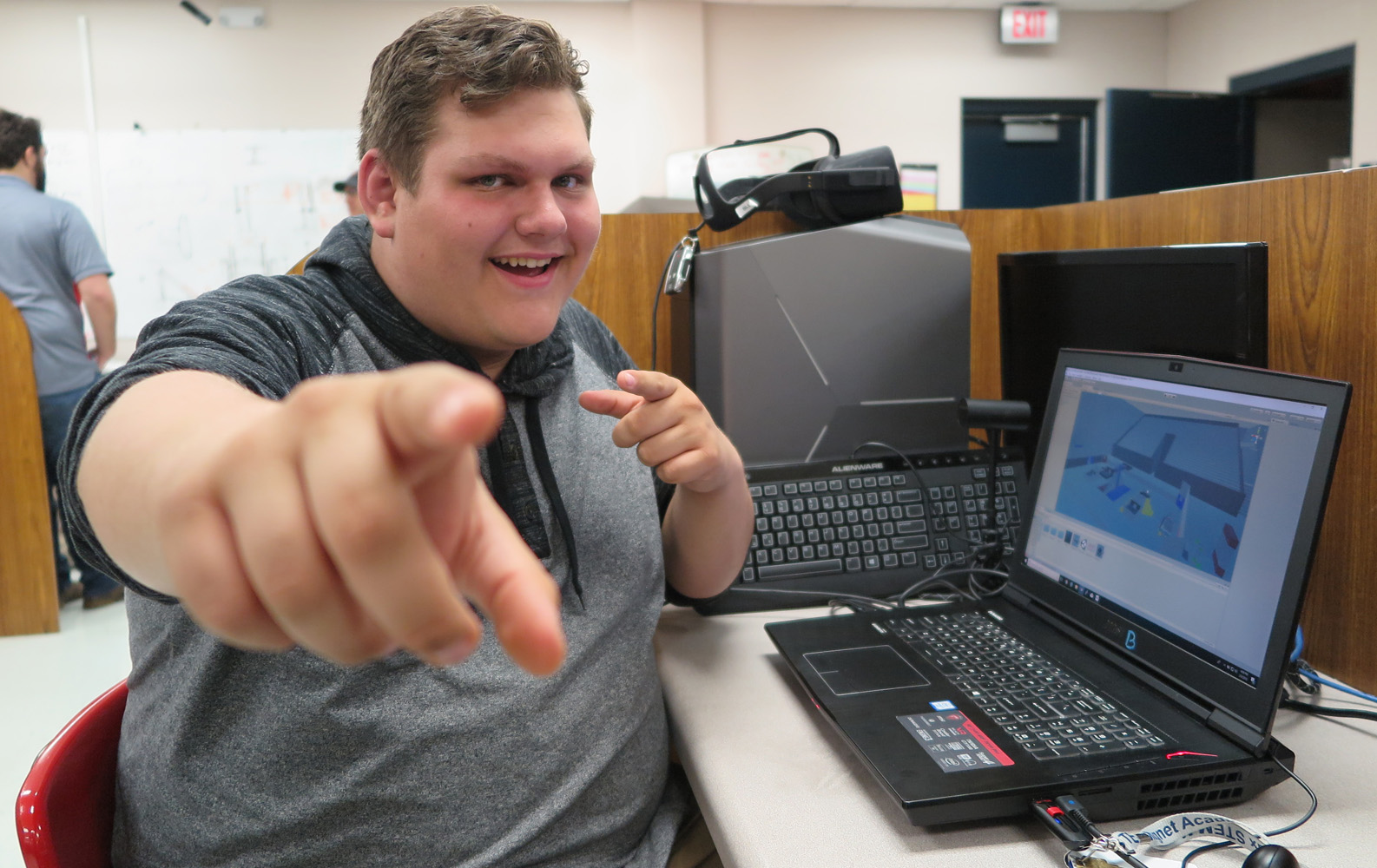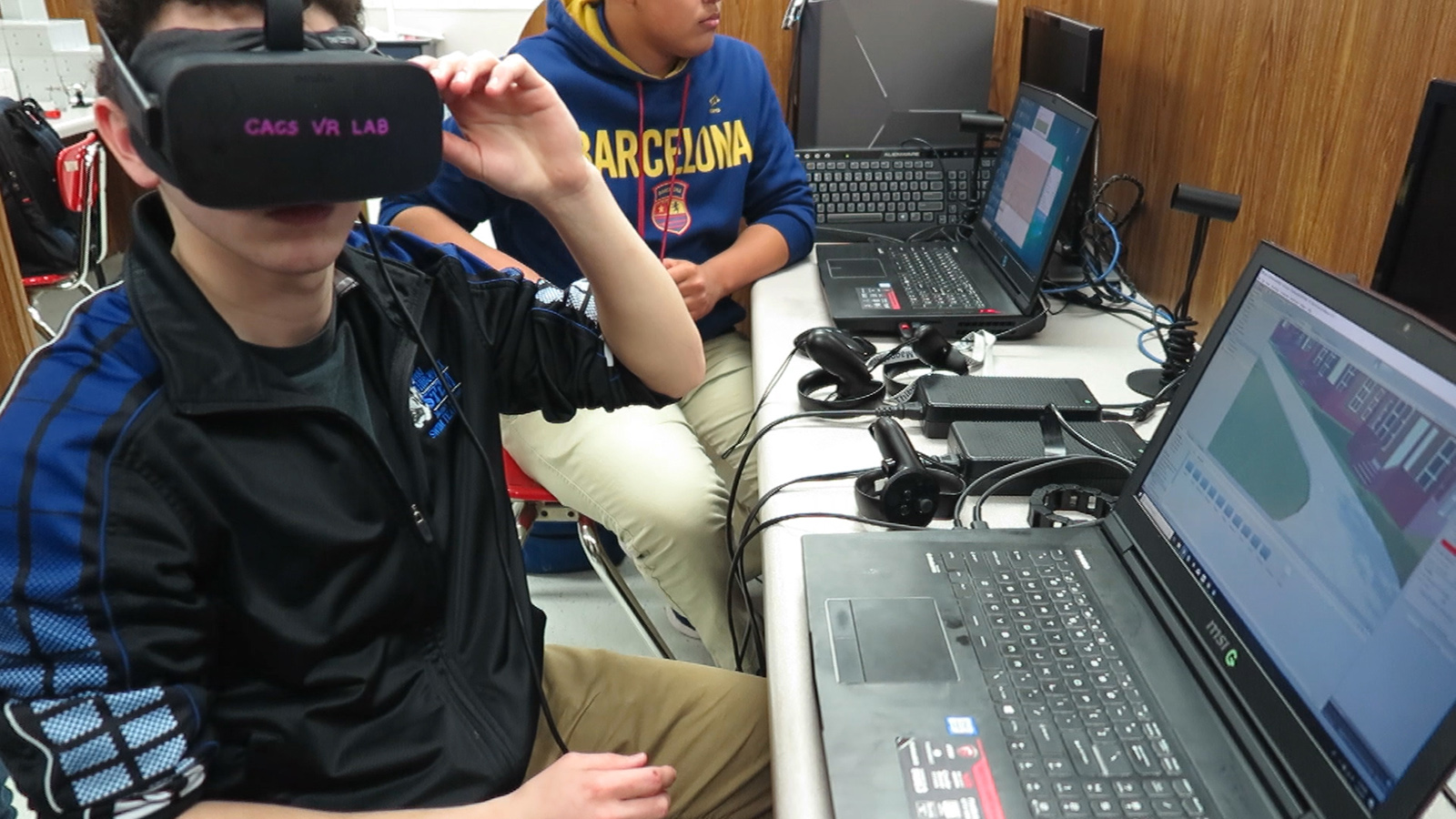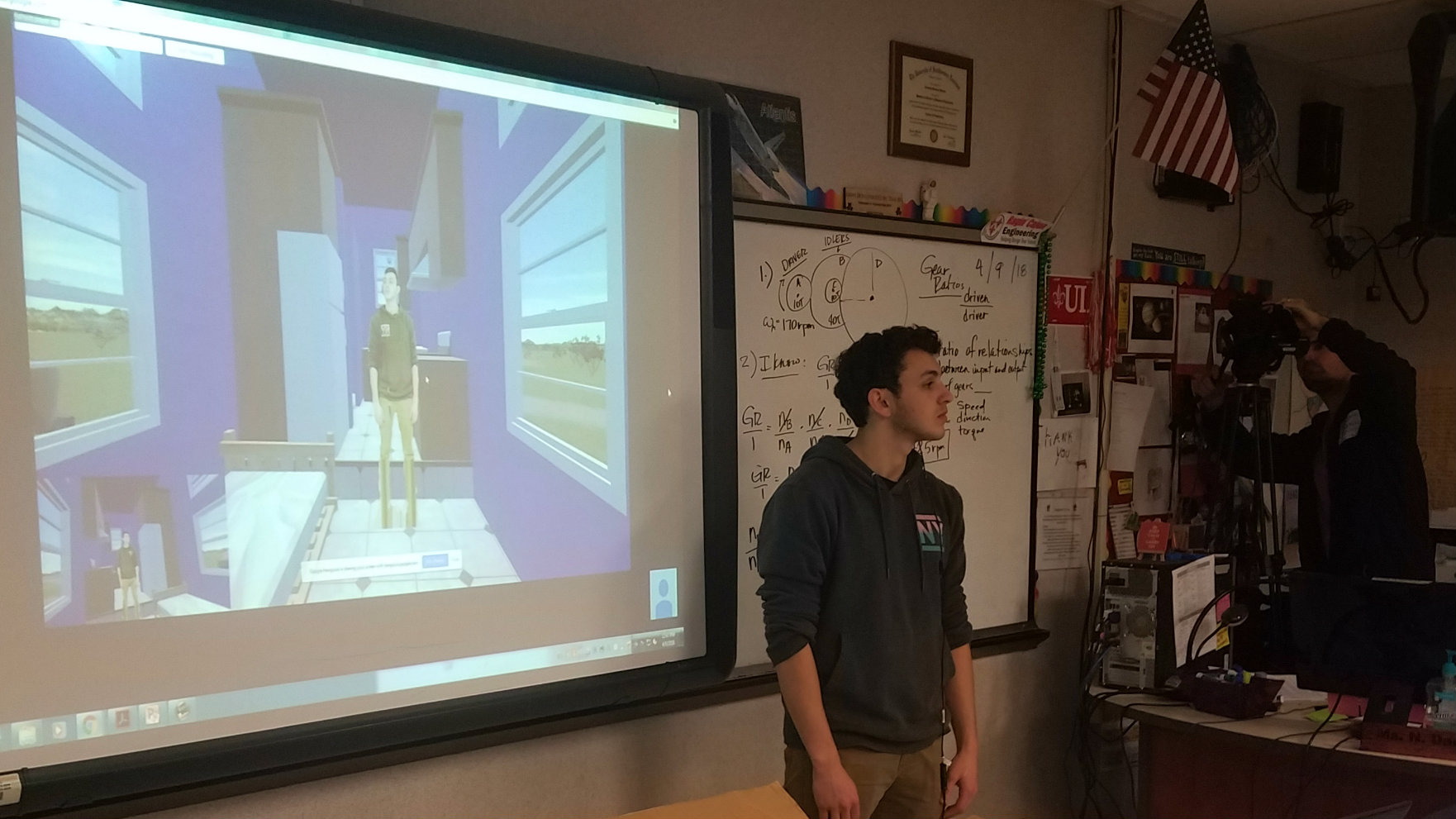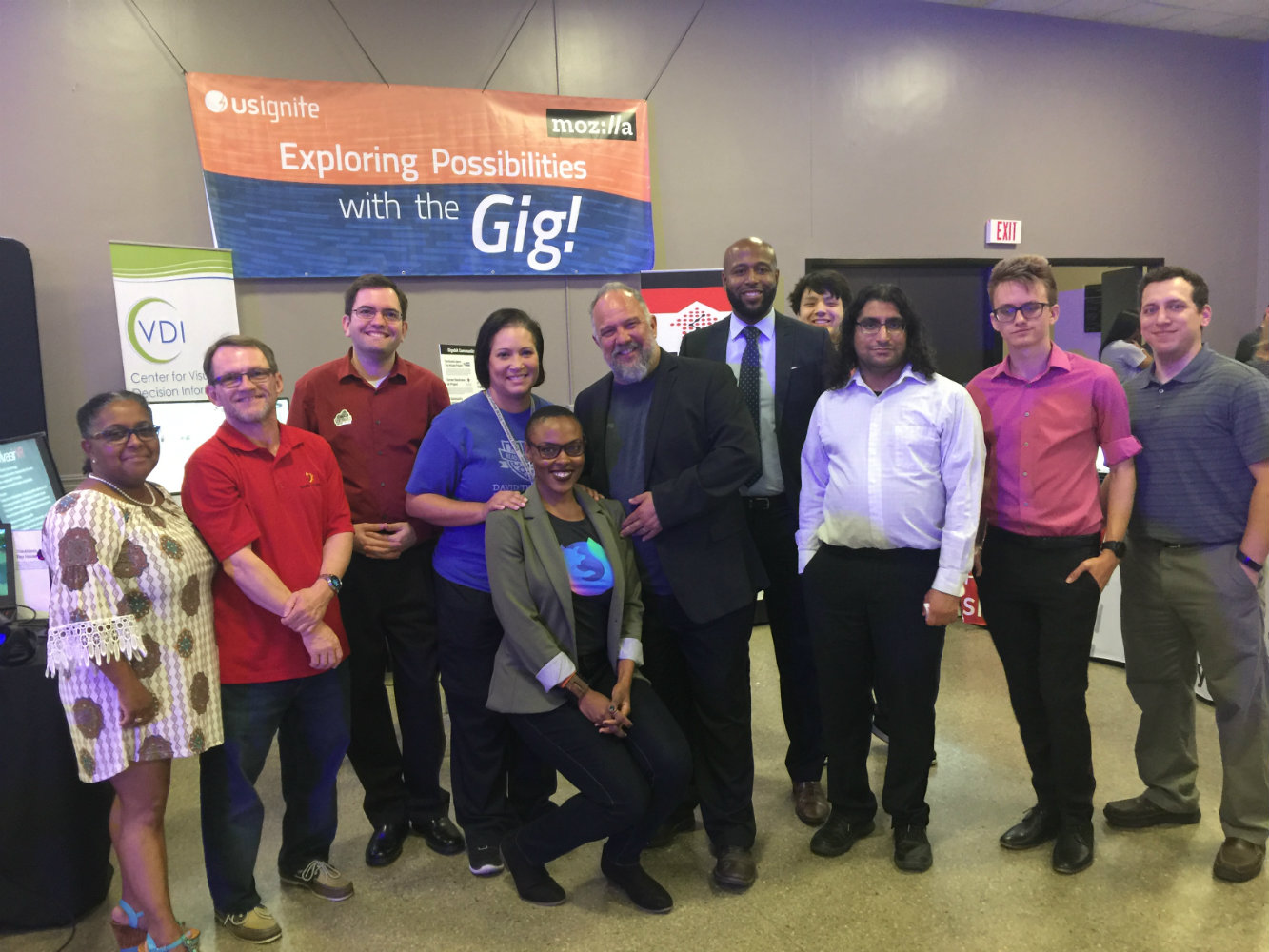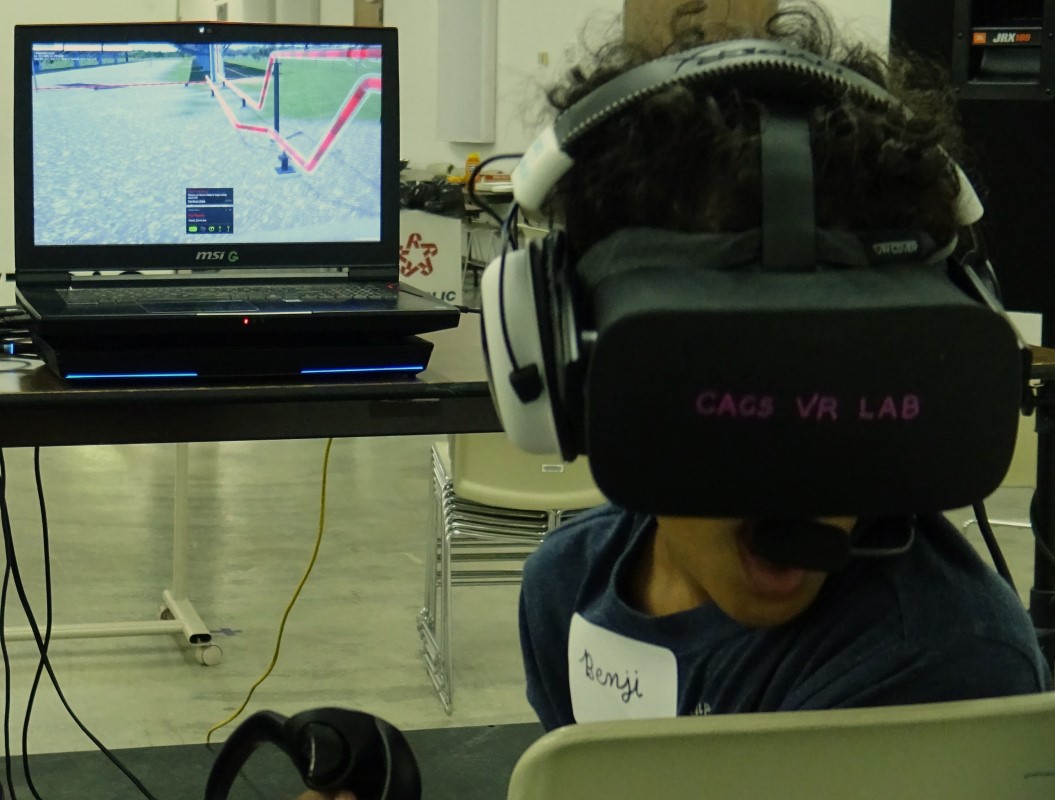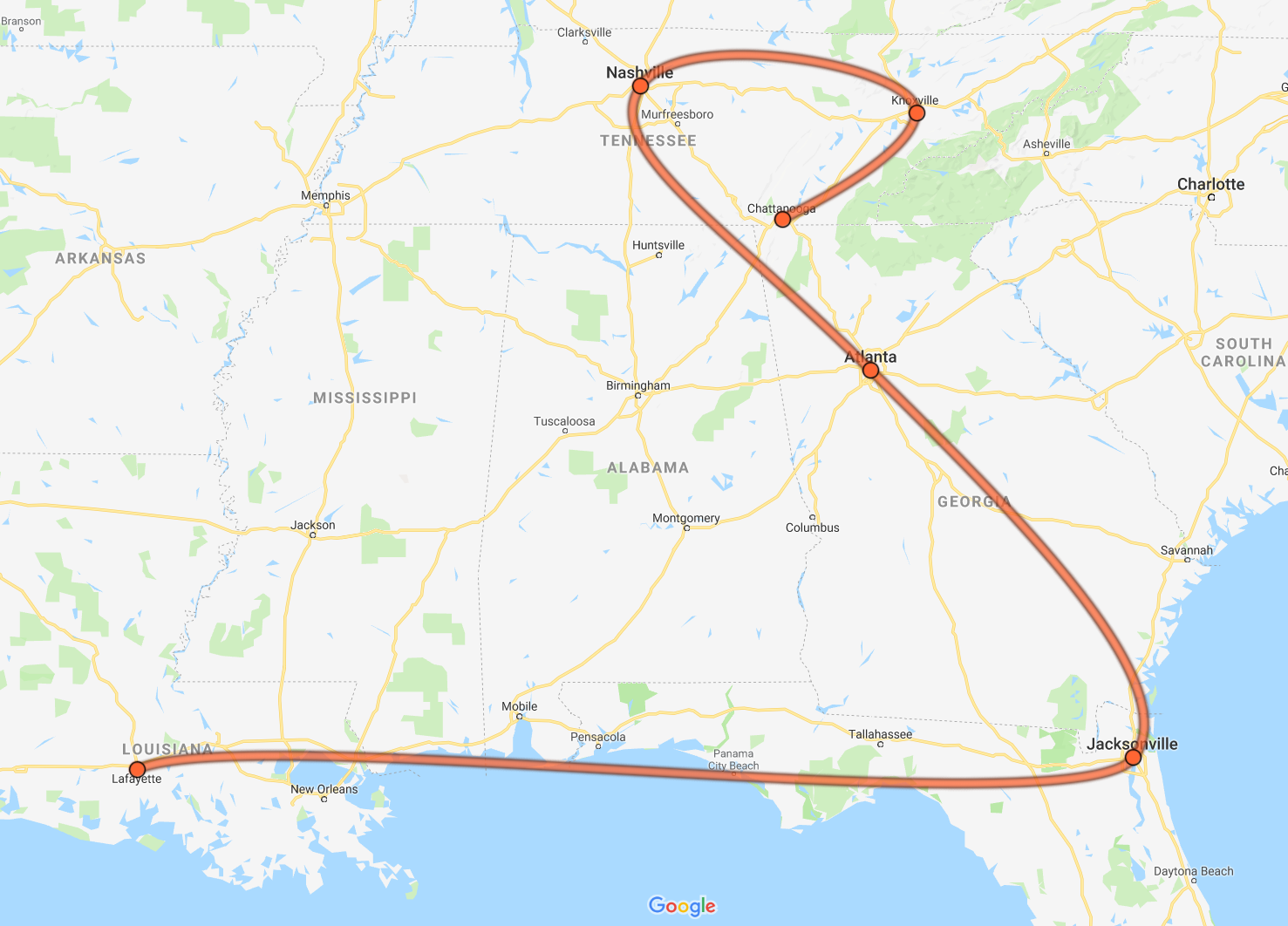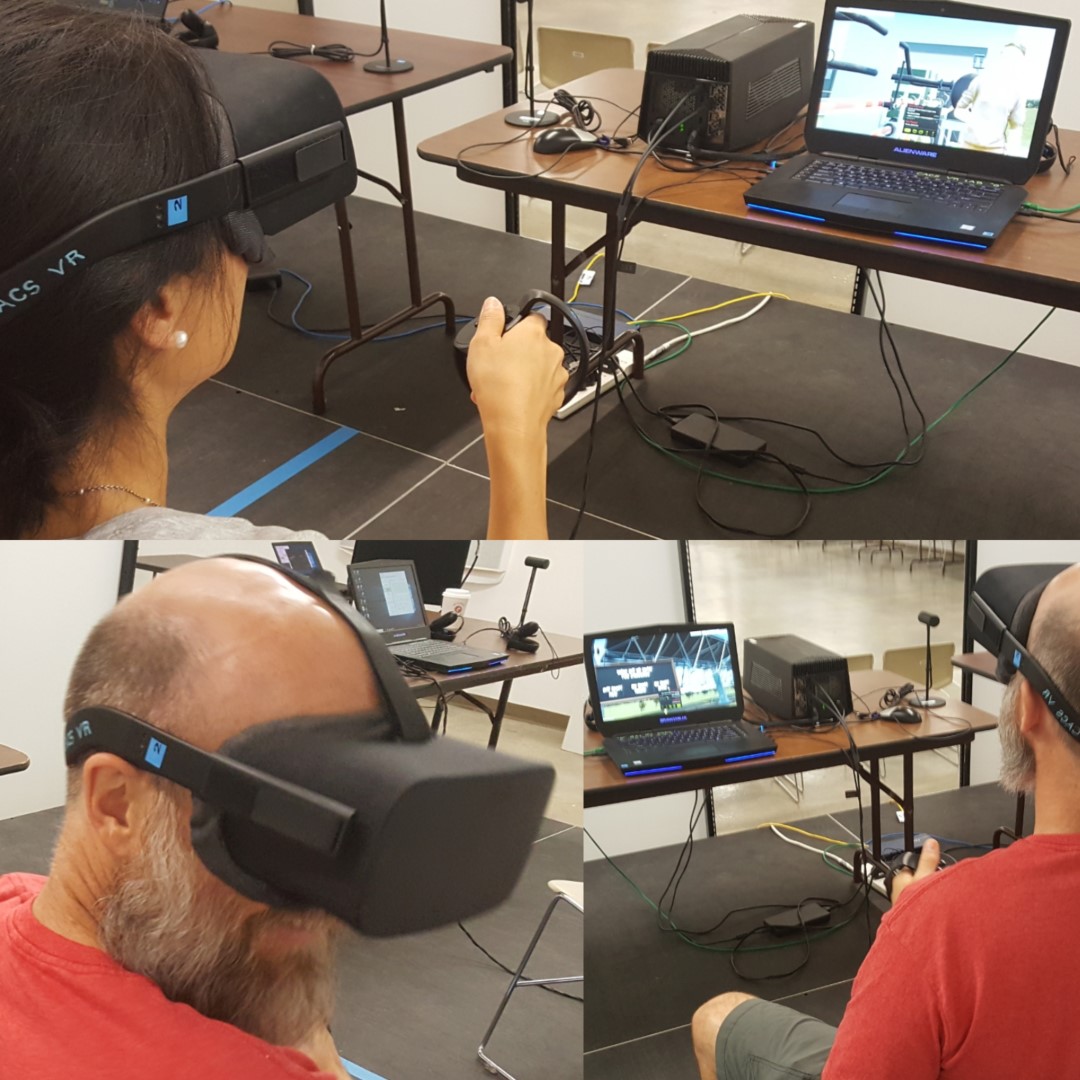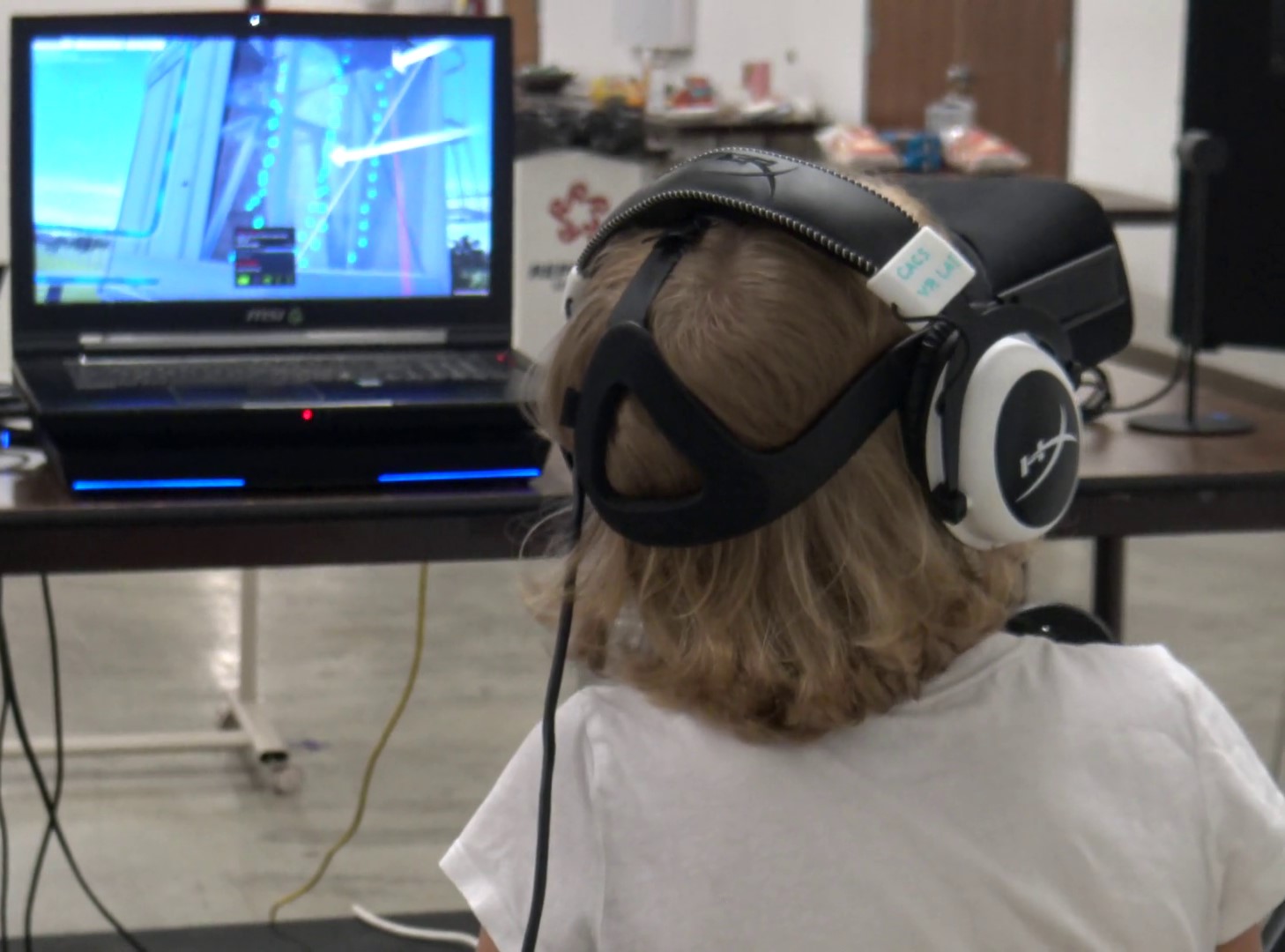Mozilla Gigabit Community Fund Blog
Introduction to Kvasir-VR: Remotely-Guided VR Field Trips
Posted by VR Lab Team in Mozilla Gigabit Community Fund Blog on October 1, 2017
The Kvasir-VR Project is developing educational networked virtual reality technology, bringing it to schools, and working with students to integrate their own VR scenes. Students wearing VR headsets are guided through virtual field trips by live teacher imagery from a 3D camera (Kinect V2). A high school group will also gain VR design experience by creating their own virtual reality scenes, which we will view with Kvasir-VR.
The current project team members include Dr. Christoph Borst (UL Lafayette Professor, Project lead), Nicolette Darjean (DTSMA Engineering Academy Educator, Project lead), Jason Woodworth and Nicholas Lipari (UL Lafayette Graduate Students), Paul Smith (UL Lafayette Undergraduate Research Student), and Adam Prejean (UL Lafayette Computer Graphics Artist). Summaries of the project and of our related prior work can be seen here:- Overview of Our Lab’s Networked VR Research
- Kvasir-VR: Teacher-Guided Shared Virtual Worlds (Mozilla Gigabit Community Project)
- Remotely Guided VR Field Trips with Kvasir VR (US Ignite Application Page)
- IEEE VR 2017 Best Research Demo Award
- Networked VR Demo Featured by US Ignite
- Press release: International demo between Lafayette and Australia
Initial Visits and Logistics
Posted by VR Lab Team in Mozilla Gigabit Community Fund Blog on October 17, 2017
Team Meeting
Anticipating possible funding, we began early in order to better align the project plan with school semester boundaries. So far we have done the following:
- The entire team had a meeting at the school to plan project coordination and high school activities.
- The graduate students demonstrated and tested a field trip application with students from the high school. This included a pilot test with over 100 students at two schools, followed by a general chat with students about the experience and virtual reality.
- We started analyzing the data from our tests of the over 75 high school students who had no prior exposure.
- We gave students a brief introduction to concepts in virtual reality regarding different devices, how VR simulates the different senses, and tips for developing for VR apps.
Student Project Overview
Posted by VR Lab Team in Mozilla Gigabit Community Fund Blog on October 26, 2017
Visit by Paul Smith and Adam Prejean
Students at David Thibodaux STEM Magnet Academy (DTSMA) have been creating models for their VR environments in Maya. We went over their plans and models and will be mentoring and checking student progress.
- The tiny house project is meant to be a VR experience of an actual tiny house being designed and built by the DTSMA students.
- The second will be a simulation of the robot arena for the school’s robotics competition.
- The third project will be a virtual representation of different types of electrical circuits.
- Another project is a rolling ball demo that shoots out pellets or picks them up, and it will conserve the mass of the player sphere while doing so.
- One project will visualize atomic structures of various elements.
- The final project is meant to be a laboratory environment investigating the periodic table.
The course at DTSMA teaches students about VR application development. Students will learn design concepts, such as creating 3D models, applying textures with best practices, using project management tools for planning and collaboration, importing 3D models into a VR environment, and creating interactable objects.
There was also a fire drill halfway through the visit. One thing we will have to figure out is how University visitors are trained to deal with emergencies and drills. Currently, visitors exit as part of the classroom. The students generally have a better idea of where to go for these situations than we do.
Project Check-In and Upcoming Demo
Posted by VR Lab Team in Mozilla Gigabit Community Fund Blog on November 9, 2017
Visit by Paul Smith and Adam Prejean
Today we visited David Thibodaux (DTSMA) to check-in with the student projects and help with an upcoming demo.
We saw an update of one student’s work. They had a small town built with some low polygon-count models and had added the standard Unity first-person controller. I offered some advice on how to get controller input. This project seemed to be intended as a demonstration at the upcoming Barnes & Noble Mini Maker Faire, while the students were waiting for some supplemental instruction for texturing in Maya.
The school is currently resolving problems with Unity licensing on school machines. At the moment, only one student is able to get Unity running on a personal laptop.
Working on Modelling and Project Management
Posted by VR Lab Team in Mozilla Gigabit Community Fund Blog on November 16, 2017
Visit by Paul Smith and Adam Prejean
Our 3D artist and I went over the basics of how to use Trello with the DTSMA students (screenshot below). We thought it best to create individual private boards for each project that are all connected under one group. The teacher at DTSMA also has administrative privileges over the boards. Students are required to communicate only over the Trello boards to allow proper supervision and protect students’ privacy.
We used one student’s model to explain some texturing concepts and modelling best practices. We encouraged the students to break their projects up into tasks before our next visit, and we emphasized the basic concepts of project management and setting feasible goals.
Unity licensing is now working on the school computers. We solved a firewall-related problem with Unity licensing. Their enterprise firewall did not allow student accounts to connect with Unity’s web-based licensing system.
Tests Suggest Advantages of Live Networked Teacher
Posted by VR Lab Team in Mozilla Gigabit Community Fund Blog on November 19, 2017
Paper Writing
Dr. Christoph Borst, Nicholas Lipari, and Jason Woodworth
Our test data from high school studies has been evaluated. We considered how the livestreamed Kvasir-VR approach compared to a non-networked version of the field trip that used prerecorded imagery. The results will be incorporated into an academic paper for a VR conference. We found that a networked version of the virtual teacher produced promising test score gains when it was experienced in a dedicated classroom for the VR. Student ratings suggest students experience a very high sense of the teacher’s presence in the environment.
Texturing Updates and Unity Assignment
Posted by VR Lab Team in Mozilla Gigabit Community Fund Blog on November 30, 2017
Visit by Paul Smith and Adam Prejean
I visited the class again this week with our 3D artist. Students are mainly working on their projects in Maya and had the following updates.
- One group of students has taken advantage of the Trello tools we showed before Thanksgiving break.
- One student (tiny house project) was making good progress with texturing.
- Our 3D artist gave some more detailed explanations on texturing in Maya to the students.
- We’ve also been added to the Trello boards to help students with questions and feedback.
I proposed an assignment for the students to complete in the next two weeks.
- The objective is to have students move some environment into Unity so they can view something they have created in VR.
- I provided a link to a Youtube playlist of a series of tutorial videos. The videos give a step-by-step process to import their Maya scenes into Unity.
- I will then bring an Oculus Rift to the class to let the students view their projects in VR.
Here are two of their models in Maya.
Intercontinental Networked VR Demo
Posted by VR Lab Team in Mozilla Gigabit Community Fund Blog on December 14, 2017
Major Demonstration
Dr. Christoph Borst and Nicholas Lipari
We are excited to announce the successful intercontinental demonstration of our networked VR system between Lafayette, LA and Adelaide, Australia. As part of the inaugural event between US Ignite and Ignite SA, 3D imagery of a virtual teacher was streamed across the globe and guided a South Australian representative through our field trip environment. The network stream traversed about 15 network hops, about 12,000 miles of fiber optic cable, and only 235 ms of network latency. The high-speed and low-latency connection was made possible by Internet2’s GENI-powered VLANs.
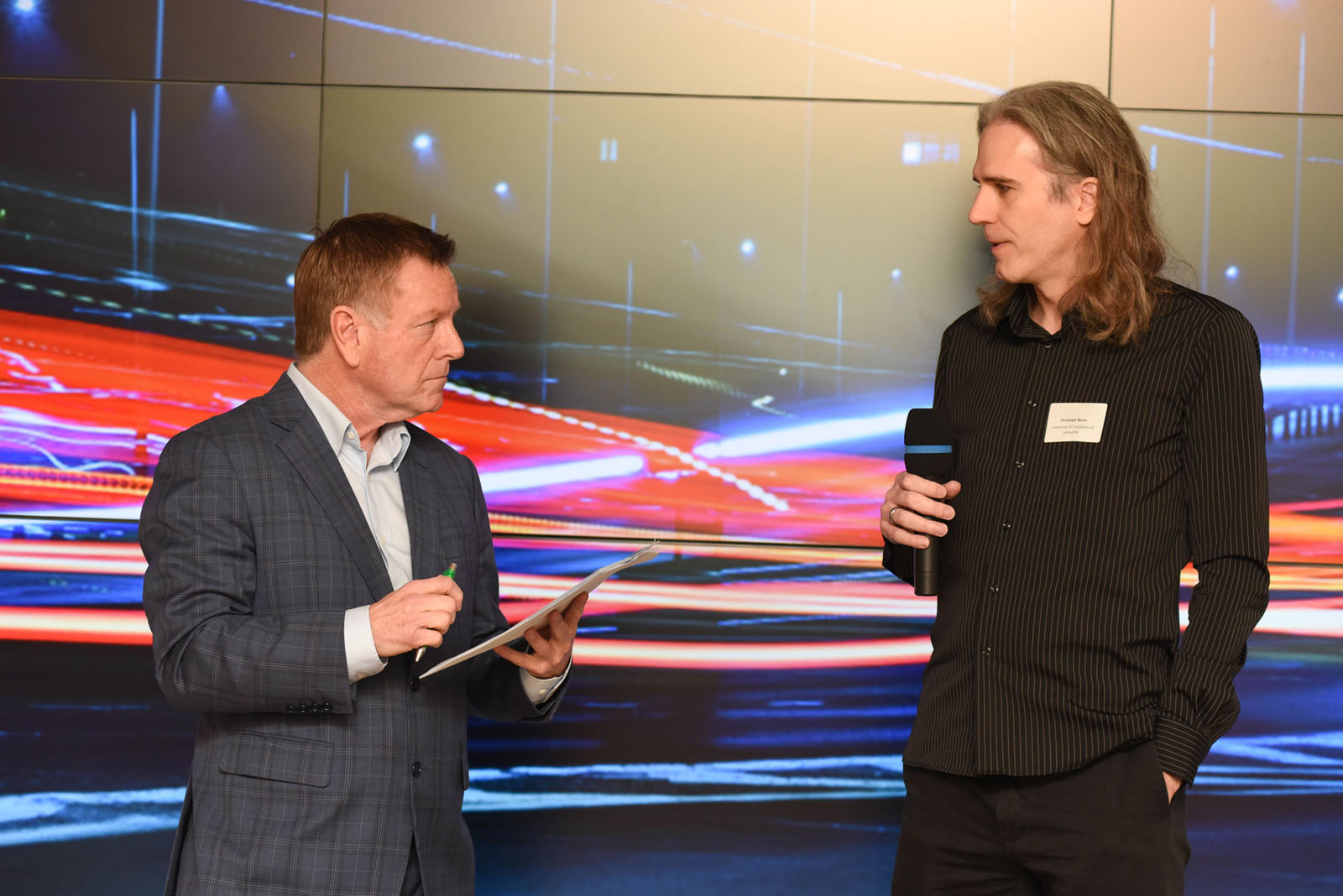
Dr. Christoph Borst being interviewed during Ignite SA Inaugural Event. Photo credit: Catherine Leo.
VR Integration
Posted by VR Lab Team in Mozilla Gigabit Community Fund Blog on January 11, 2018
Visit by Paul Smith, Adam Prejean
The high school is back in session. Our artist and I went to the high school to check up on the assignment that we issued in December. Of the previous semester’s projects, the students in three concluded their work at the fall semester end and moved on to other classes. There are three remaining student projects being developed.
Since the last time we visited, the following have been achieved. We’ve been trying to find ways of accommodating students since much of their work happens at home where none of them have VR headsets.- We were able to add a VR simulation program to a student’s scene successfully.
- We are using a tool called VRTK for this simulation, as well as other interactive bits that the students may wish to add to their projects (if time allows).
One of the student projects, a Tiny House, was imported into Unity. See the screenshots below.
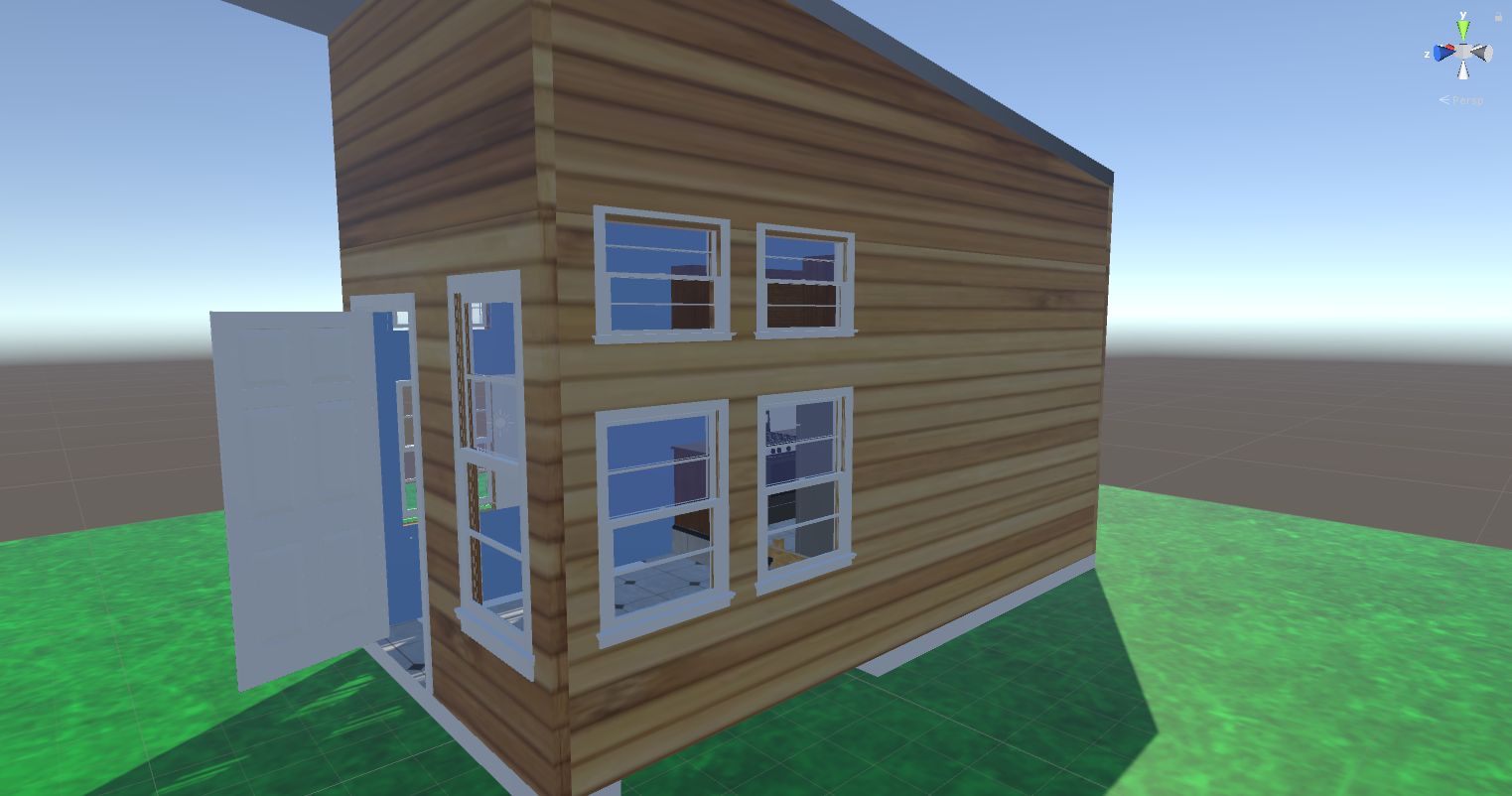
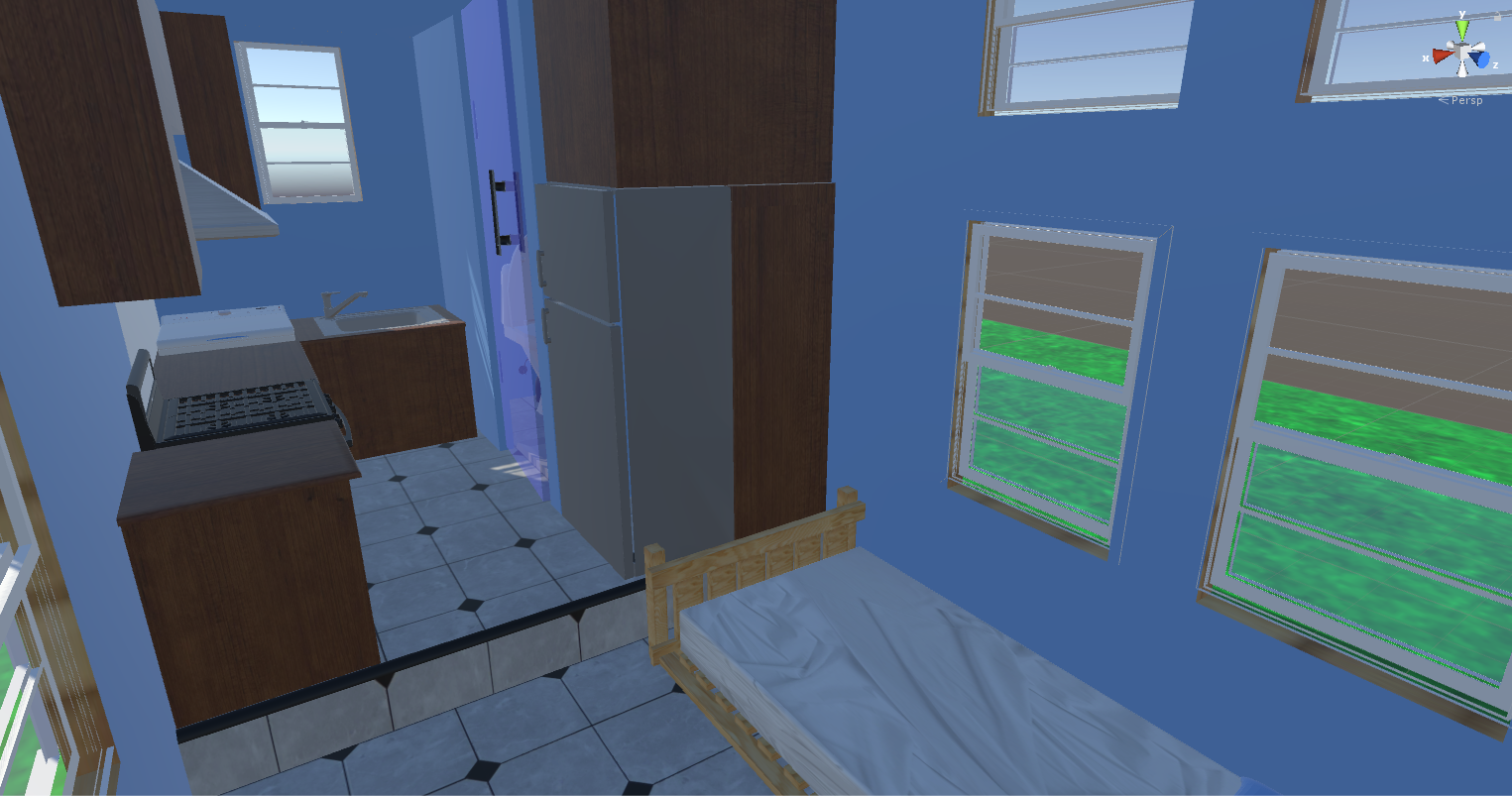
School-to-School Network Test
Posted by VR Lab Team in Mozilla Gigabit Community Fund Blog on January 11, 2018
Visit by Nicholas Lipari and Paul Smith
We conducted gigabit network tests using Lafayette Parish School System’s high speed network, streaming the virtual teacher from Carencro High School to David Thibodaux STEM. With this capability, students and teachers from one school could meet someone from the other school. These two Lafayette high schools are about 12 miles apart. The Lafayette Parish School System operates a parish-wide high school network with 10 gigabit links in-between campuses.
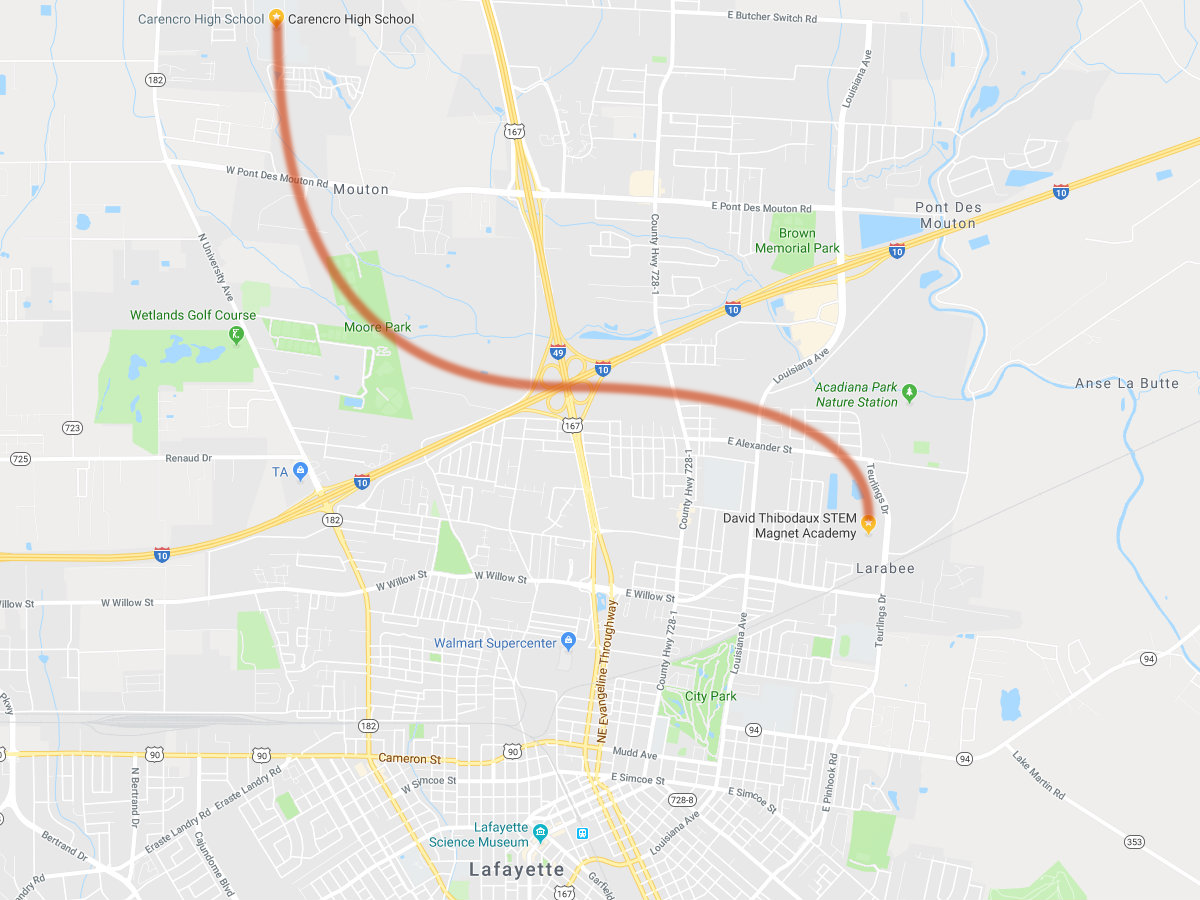
LPSS network connecting Carencro High School to David Thibodaux STEM
separated by about 12 miles. Image courtesy of Google Maps.
School Updates From Last Two Weeks
Posted by VR Lab Team in Mozilla Gigabit Community Fund Blog on February 1, 2018
Visits by Paul Smith and Adam Prejean
We visited the school three times in the past two weeks. Here are the main updates from these visits:
- On Jan 23, we gave an final assignment to add actual VR camera rigs to their scenes. The scenes are progressing nicely, showing significant progress since before the break.
- As of the 30th, students now have VR integrated into their scenes! It was great getting to see the students reactions to view their environments in VR for the first time.
- On Feb 1, we worked with the students setting up their new computers and headsets and going over best practices when working at a desk with VR equipment.
We were very excited to see how far the students have progressed since starting their projects.
Photos by Dr. Christoph Borst
Video for Upcoming Conference Paper
Posted by VR Lab Team in Mozilla Gigabit Community Fund Blog on February 7, 2018
Dr. Christoph Borst, Nicholas Lipari, and Jason Woodworth
A paper on Kvasir-VR will appear at IEEE VR 2018, the premiere academic VR conference. The paper includes analyzed data from the studies at high schools. It summarizes approaches for embedding a teacher into VR, shows promising test score gains for our main approach, and shows that students give very high ratings of the networked teacher (especially in terms of co-presence, overall rating, and perceived helpfulness of educational elements). Dr. Borst will present the paper in late March in Reutlingen, Germany.
We prepared a video to accompany the paper. Play the video below for an overview of the networked VR approach and environment used in the study.
Networking Integration and Fly-through Videos
Posted by VR Lab Team in Mozilla Gigabit Community Fund Blog on February 20, 2018
Visit by Paul Smith and Adam Prejean
We worked with students to view their models in our Kvasir-VR system. Some of the tiny house models needed to be adjusted to work in our original implementation. The others should not require the same changes involving terrain geometry.
Students were also assigned to make fly-throughs for each of their environments with the Camera Path Creator tool. Fly-through videos of the tiny house, robotics competition arena, and circuits projects are show below.School-to-School Gigabit VR with Tiny House
Posted by VR Lab Team in Mozilla Gigabit Community Fund Blog on April 9, 2018
Visits by Jason Woodworth and Nicholas Lipari
We deployed a Kvasir-VR field trip with a student’s Tiny House scene across a network between Carencro High and DTSMA. On March 8th, we first setup a simplified and portable version to test various network-related parameters. On March 13th, we helped LPSS configure their network to allow Steam and SteamVR through their firewall. On March 15th, a remote teacher (Jason at DTSMA) was streamed from DTSMA and explained virtual environments to students at Carencro High.
The final Tiny House VR scene was shown loaded into Kvasir-VR on April 9. DTSMA student Andre Garcia was streamed to several students at Carencro High and explained the Tiny House. To give the students a way to build their own networked VR environments in the future, we are suggesting to students which online tutorials to start with and how to add basic Unity networking scripts to their projects.Demo Showcase at the Mayor’s Annual Address
Posted by VR Lab Team in Mozilla Gigabit Community Fund Blog on April 12, 2018
UL Lafayette and DTSM Team
On April 12th, we showed Kvasir-VR and two applications at the Robideaux Report Showcase of Culture & Technology. The event was an opportunity for residents and local tech leaders to see regional innovations.
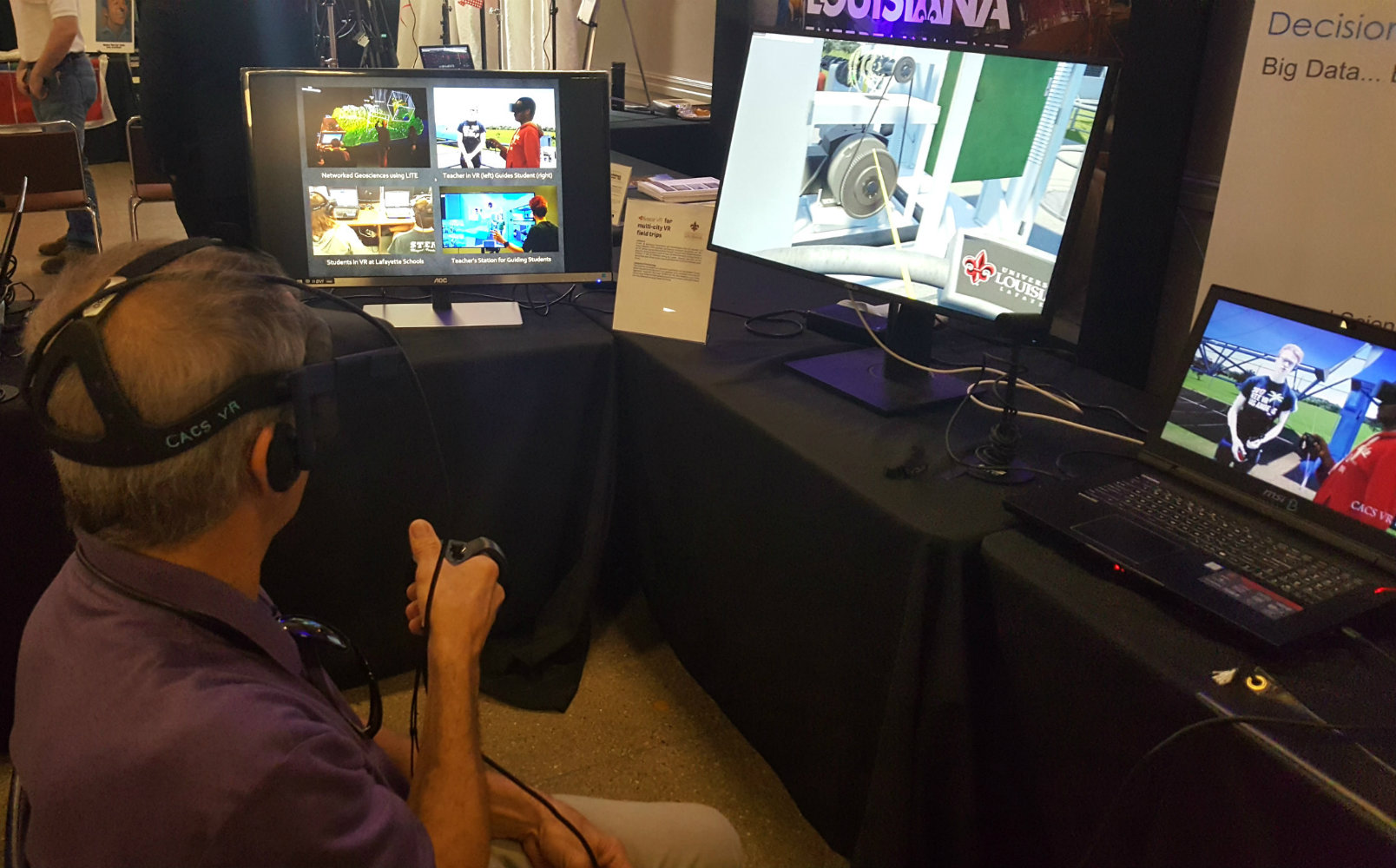
Visitors experienced Kvasir-VR field trip techniques in two related VR scenes — a solar plant and a tiny house in a pocket community.
Round 3 Project Wrap-Up
Posted by VR Lab Team in Mozilla Gigabit Community Fund Blog on April 15, 2018
The original Mozilla project period has ended. Round 3 highlights are:
- We experimentally assessed learning and compared the two Kvasir-VR approaches, “in the field”, with real students in classrooms. Results were published at the main academic VR conference.
- Team members guided the first high school VR curriculum in the Lafayette school system, broadening the public school curriculum. Students created 3D environments with modeling and game engine tools, integrated VR equipment, and documented steps with a project management system.
- We established school-to-school networked VR and we believe it is the first networked deployment of this type in the region. This also helped schools configure and test other teleconferencing software that enabled distant classrooms to meet each other.
- Kvasir-VR was featured in major showcase and outreach events. This included operation over an intercontinental gigabit network at the launch of a new global gigabit community initiative.
Some documents related to the project are found below:
Round 4 Funding for Kvasir-VR: Cross-community Deployment
Posted by VR Lab Team in Mozilla Gigabit Community Fund Blog on May 1, 2018

We are excited to announce Round 4 Mozilla funding for a cross-community deployment of Kvasir-VR. We are bringing our networked VR field trip technique from Lafayette, LA to the Chattanooga, TN area. The project connects two geographically-separated gigabit communities and evaluates educational aspects of the VR-embedded teacher. Additionally, VR infrastructure and curriculum guidance will be provided to the participating schools for educators to build course content for longer-term benefit.
The project members for this round include Dr. Christoph Borst (UL Lafayette, Project lead); Geoff Millener and Andrew Rogers (The Enterprise Center, Digital Equity Representatives); Jason Woodworth and Nicholas Lipari (UL Lafayette Graduate Students); and Robert Dodson, Jonathan King, and John Maynard (Hamilton County Educators).Kvasir-VR Connects Two Gigabit Communities
Posted by Lab Administrator in Mozilla Gigabit Community Fund Blog on June 24, 2018
We are happy to report a successful deployment of Kvasir-VR networked educational VR between Lafayette, LA and Chattanooga, TN. We connected the two gigabit communities and showed a teacher from Lafayette, LA streamed into an educational VR environment on display at the Downtown Library Branch in Chattanooga, TN. Adding to prior work with Austin, TX and Adelaide, Australia, this marks yet another connection established between Lafayette, LA and other gigabit communities to bring innovations in educational technology to community members, including high school students, educators, and professionals.
During our time in Chattanooga, we are offering library patrons the opportunity to learn about an energy plant from a remote teacher in Lafayette, LA. We are also meeting with teachers from local Chattanooga schools to discuss VR course activities and explain Kvasir-VR. Several have expressed interest in adding VR scene creation into their curriculum, following our pilot course during the previous round of Mozilla’s Gigabit Community Fund.
We worked through some technical difficulties before arriving in Chattanooga. Collaborating with staff from the Downtown Library Branch and the Enterprise Center, we tested the high-speed connection via Internet2. After meeting with library staff on the first Monday morning of our visit, we tested and calibrated the Internet2 connection. Some synchronization parameters needed to be measured between Lafayette, LA and Chattanooga, TN. The route taken for our virtual avatar passed through Internet2 nodes in Baton Rouge, LA, Jacksonville, FL, Atlanta, GA, and Nashville, TN. From there the Universities of Tennessee at Knoxville and Chattanooga provided transit, and the Electric Power Board of Chattanooga provided last mile service. From UL Lafayette to the Downtown Library Branch we experienced just 35 ms of network delay.
Kvasir Demonstrations at Chattanooga Downtown Library 4th Floor
Posted by Lab Administrator in Mozilla Gigabit Community Fund Blog on July 3, 2018
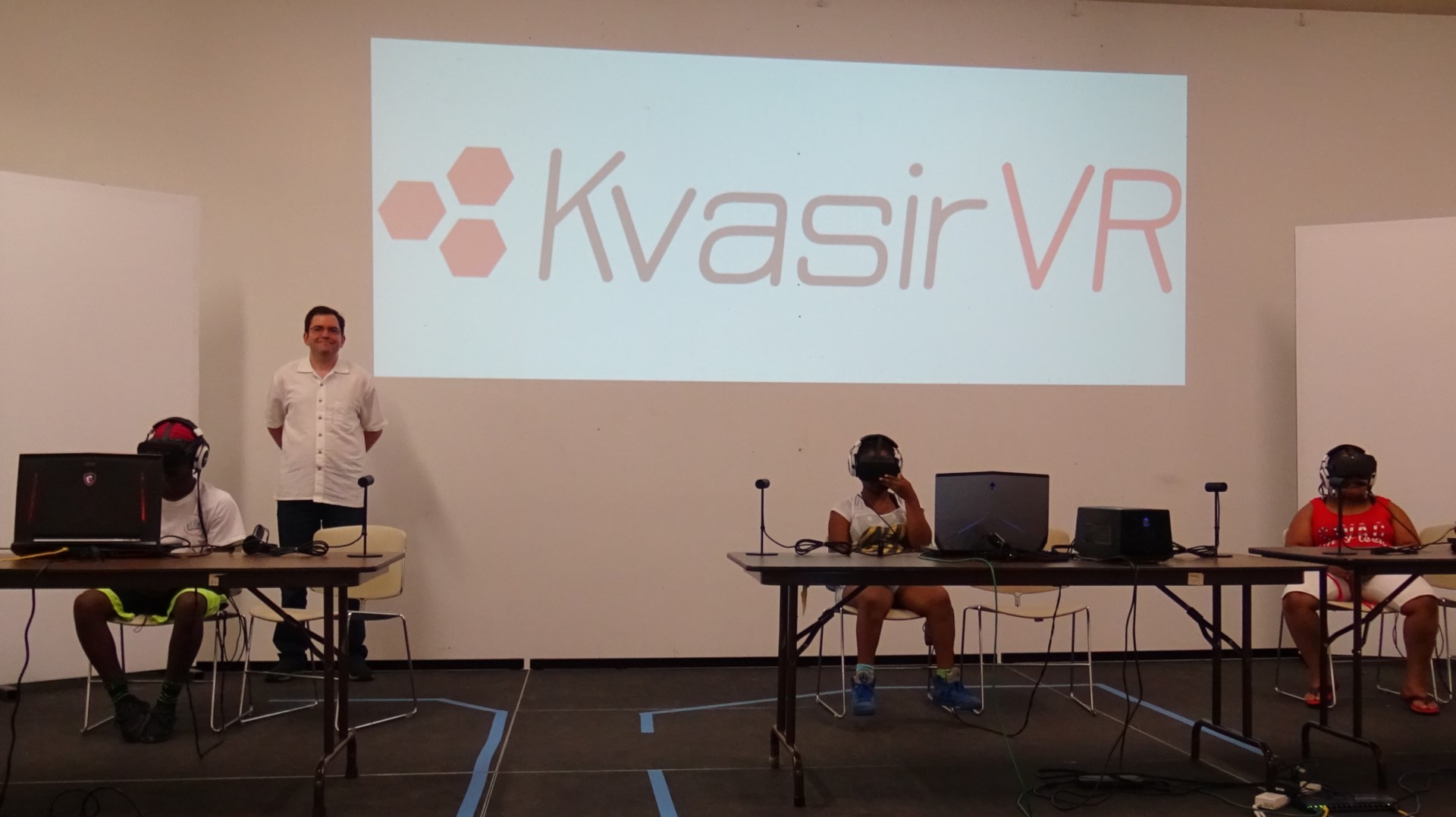
Three VR stations were on a stage at the library’s 4th floor Giglab. Students had plenty of room to move and gesture while seated. The classroom-deployable VR experience was developed during prior NSF-funded work on teacher-guided educational VR.
The Kvasir-VR demo was available to the library’s patrons and staff in the 4th Floor’s Giglab from June 27th to July 3rd for 8 hours a day. They all gave helpful feedback on the learning environment, and we were able to collect some preliminary data.
Here are some of the main highlights from our visit:- On June 27th, we met with educators from Hamilton County schools. The teachers are interested in deploying VR in their classrooms and sought our input on logistics and course topics.
- On June 28th, we welcomed our first groups of students from the day’s library patrons.
- On June 29th, we joined with a Machine Learning summer camp and led their students through a virtual tour.
- On July 2nd, we also tested standalone version of Kvasir-VR on the library’s VR PC with an HTC Vive. The experience was on par with our VR stations, and we plan to provide an updated permanent demo for their patrons on the 4th Floor.
- On July 3rd, just as we were about to pack everything to leave, a rush of two groups arrived at the end of the day, helping us to end on a high note.
A deep thank you to all of the staff and patrons at the Downtown Chattanooga Library for their hospitality, assistance, and participation during our visit. Including: Rob Wichtman, Meredith Levine, and Kristen O’Connor (Chattanooga Public Library); and Geoff Millener (Enterprise Center).
Alternative Teacher Avatar Experiments
Posted by Lab Administrator in Mozilla Gigabit Community Fund Blog on July 5, 2018
We have been evaluating different ways to show the teacher to students in Kvasir. The main teacher avatar, a 3D video avatar, gives the students a fully realistic representation of their teacher. However, we would like to understand the effectiveness of alternative avatars that vary in terms of realism and the amount of information about the teacher they expose. We anticipate that this will help us learn what kind of avatar is necessary to give the students an engaging and effective experience.
We deployed two additional avatars for experimentation during the library visit. We demonstrated the three teacher avatars to students in Chattanooga to gather feedback for use in further development. During a three-student demo of Kvasir, each student was shown a single different avatar. Many were asked about their thoughts on how the teacher looked and how they felt learning from it. Several curious students were shown other avatars after their initial demo and were asked which they might prefer learning from. This feedback will help us refine our approaches for further experiments on avatar effectiveness.Team Members Attend Mozilla Gigabit Celebration
Posted by Lab Administrator in Mozilla Gigabit Community Fund Blog on August 15, 2018
Project members visited Mozilla Headquarters in Mountain View, CA, for the Gigabit Community Fund Celebration that wraps up the projects. Attendees included other Gigabit Community Fund grantees from Lafayette, LA, Austin, TX, Chattanooga, TN, and Eugene, OR.
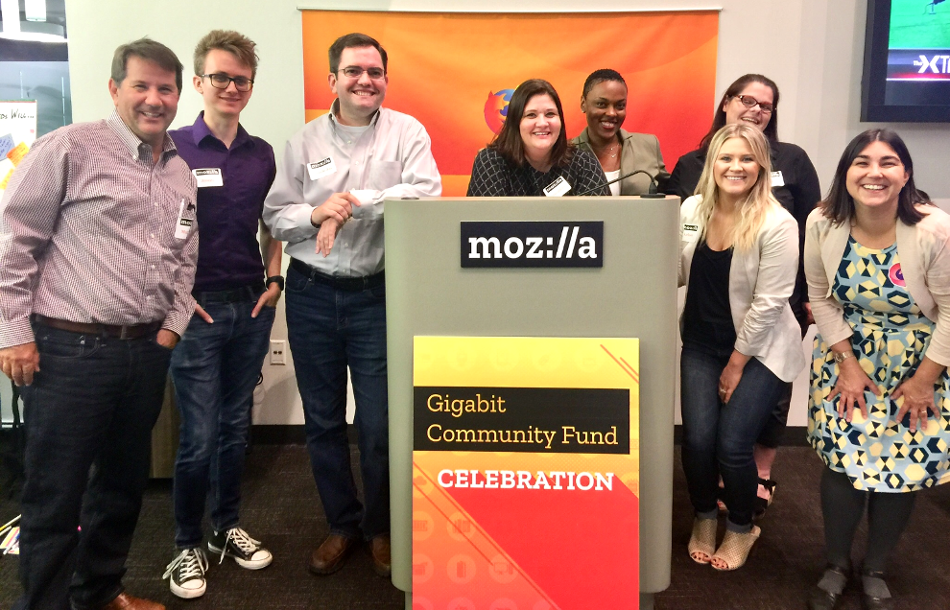
Mozilla Project Wrap-up and Mozilla/AOC Mini-Documentary
Posted by Lab Administrator in Mozilla Gigabit Community Fund Blog on August 30, 2018
The project and this blog have wrapped up. Round 4 highlights are:
- An interstate networked deployment of a live-guided VR field trip, shown to visitors of the Chattanooga Downtown Library across 9 days.
- Infrastructure enabling Chattanooga schools to initiate a VR curriculum.
- Knowledge gained was used to assist the Acadiana Center for the Arts in their Mozilla project on Low Latency (LoLa) meetings for musicians.
- We documented the setup and use of Kvasir-VR in a guide that will be provided to teachers, including our experience in deploying Kvasir-VR to Chattanooga in a case study.
Moving forward, we are continuing our educational VR work:
- We obtained funding for 3 more years of educational VR research (University announcement, NSF Award 1815976). The focus will be on making the VR field trips more responsive to sensor data related to user attention or focus.
- We are preparing a more extensive experiment on networked teacher avatars. These experiments will take place at UL Lafayette and area high schools
Our project and department were featured in the following wrap-up documentary from Mozilla and AOC Community Media.

